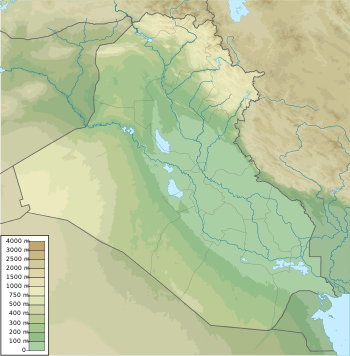Tell Arpachiyah
 Shown within Iraq | |
| Alternate name | Tepe Reshwa |
|---|---|
| Location | Nineveh Province, Iraq |
| Region | Northern Mesopotamia |
| Coordinates | 36°29′N 42°57′E / 36.483°N 42.950°ECoordinates: 36°29′N 42°57′E / 36.483°N 42.950°E |
| Type | tell |
| Site notes | |
| Excavation dates | 1933, 1976 |
| Archaeologists | M. Mallowan, J. Cruikshank Rose, I. Hijara |
Tell Arpachiyah (outside modern Mosul in Ninawa Governorate Iraq) is a prehistoric archaeological site in Nineveh Province (Iraq). It takes its name from a more recent village located about 4 miles (6.4 km) from Nineveh. The proper name of the mound on which the site is located is Tepe Reshwa.
History of archaeological research
After being scouted by Reginald Campbell Thompson in 1928, it was excavated by Max Mallowan and John Cruikshank Rose of the British School of Archaeology in Iraq, along with Agatha Christie in 1933.[1] Additional soundings were conducted in 1976 by a team led by Ismail Hijara.[2][3] Several Halaf structures were uncovered, including tholoi and the "Burnt House". An array of Halaf pottery and sealings were also found, along with some Ubaid burials.
Tell Arpachiyah and its environment
Tell Arpachiyah is a small tell, or settlement mound, with a maximum diameter of 67 metres (220 ft) and a peak height of 5.5 metres (18 ft). The full site has a diameter of around 125 metres (410 ft).
Occupation history
The site was occupied in the Halaf and Ubaid periods. It appears to have been heavily involved in the manufacture of pottery. The pottery recovered there formed the basis of the internal chronology of the Halaf period.
See also
References
Further reading
- Hijara, Ismail. The Halaf Period in Northern Mesopotamia, Nabu, 1997, ISBN 1-897750-06-4
- Stuart Campbell, The Burnt House at Arpachiyah: A Reexamination, Bulletin of the American Schools of Oriental Research, no. 318, pp. 1–40, 2000
- Peter M. M. G. Akkermans, Glenn M. Schwartz, The Archaeology of Syria: From Complex Hunter-gatherers to Early Urban Societies (c. 16,000-300 BC), Cambridge University Press, 2003, ISBN 0-521-79666-0
- T. Davidson and H. McKerrell, The neutron activation analysis of Halaf and Ubaid pottery from Tell Arpachiyah and Tepe Gawra, Iraq, vol. 42, pp. 155–67, 1980
